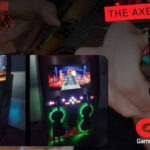When discussing musical instruments, guitars often take center stage. Guitars, especially electric guitars, are undeniably iconic, but even the finest hollow-body guitar needs assistance to truly resonate. To amplify one of the world’s most beloved instruments, guitar amplifiers are essential and deserve recognition. These crucial components, often referred to simply as “guitar amps,” are the powerhouses of any guitarist’s setup. They transform the subtle electrical signals from your guitar into the inspiring sounds that guitarists and audiences adore. This article will delve into the world of Guitar And Amp combinations, exploring the different types and their roles in shaping your sound.
Combo Guitar Amps: All-in-One Versatility
For guitarists seeking straightforward and portable amplification, combo guitar amps are an excellent starting point. These all-encompassing units neatly integrate the preamp, power amp, and speakers into a single cabinet. This design makes them incredibly convenient for situations demanding quick setup and teardown. Rehearsals, street performances, and smaller gigs in intimate venues are all made easier with a combo amplifier. The combo amp is truly a versatile workhorse, a fundamental piece of gear that every guitarist should consider for their “guitar and amp” setup.
Alt text: Versatile combo guitar amplifier, an all-in-one solution for guitar amplification, ideal for practice and small gigs.
Amplifier Heads and Speaker Cabinets: The Stack Advantage
Moving beyond the all-in-one design, amplifier heads represent the standalone electronic brains of an amp setup. An amp head is engineered to connect to external speakers, often delivering significantly more power than the amplifier section found in a combo amp. The head unit itself is comprised of two key circuits: the preamp and the power amp. These circuits are critical factors when selecting any “guitar and amp” combination, whether it’s a combo or a head and cabinet setup, as they are central to the tonal character and where components like vacuum tubes come into play. Explore options like the Fender Bassbreaker Amplifiers, which blend modern features with classic Fender sonic DNA.
Alt text: Guitar amplifier head and speaker cabinet stack, a powerful setup providing enhanced volume and tonal control for electric guitar amplification.
Tube Amps vs. Solid-State Amps: Tone and Technology
When considering the internal workings of your “guitar and amp” rig, the choice between tube and solid-state amplifiers significantly impacts your sound. If you’re aiming for a warmer, richer tone, characterized by pleasing distortion and a vintage feel, a tube-based amplifier is often the preferred choice. Conversely, solid-state amplifiers might be more suitable if you prioritize a clear, pristine sound and exceptional reliability. Ultimately, the best option depends on your individual sonic preferences and performance needs when building your ideal “guitar and amp” setup.
Matching Speakers to Your Amp Head: Power and Configuration
For those opting for standalone amplifier heads, speakers and speaker cabinets become indispensable partners. When selecting speakers, carefully consider the total power handling capacity to ensure your speaker setup can manage the output of your amp head without damage and deliver the volume you require for your performance venues. Speaker configuration also plays a crucial role in shaping your sound. Larger woofers are designed to reproduce powerful bass frequencies, while smaller tweeters excel at delivering clear high-end tones. Matching the right speakers to your amp head is paramount in achieving a balanced and powerful “guitar and amp” sound.
Alt text: Guitar speaker cabinet close-up, showing woofer and tweeter components essential for projecting amplified guitar sound.
Choosing the Right Guitar and Amp for the Venue
Selecting the appropriate “guitar and amp” combination is crucial for any performance venue. Using an excessively powerful amplifier in a small club is not only unnecessary but also creates extra setup work. A smaller combo amp would be a far more practical and efficient choice in such situations. Conversely, attempting to use a small amplifier in a large theater might result in a significant portion of the audience struggling to hear you. Take the time to carefully evaluate your typical performance environments to determine the best “guitar and amp” solution that will provide optimal sound and convenience.
In conclusion, guitar amplifiers are indispensable tools for electric guitarists, shaping the instrument’s voice and enabling it to be heard across diverse settings. Whether you choose the portability of a combo amp or the power and flexibility of a head and speaker cabinet, understanding the nuances of “guitar and amp” pairings is essential for every guitarist seeking to craft their ideal sound.

